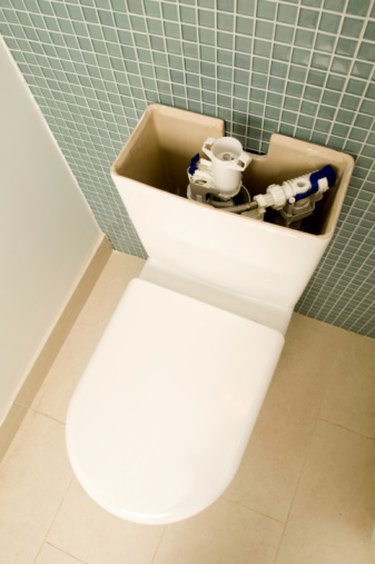
Toilet tank sweating can occur during any season if the right environmental factors are in place. While water around the toilet is usually a sign of a serious malfunction, toilet tank sweating is not due to a malfunction, and quite a few options exist to address the issue and stop it from occurring.
Cause
Video of the Day
Toilet tank sweating is caused by a combination of factors: the temperature of the water coming into the tank and the temperature and humidity of the air in the room. When the water is colder than the room -- and thus chills the tank -- sweating occurs.
Video of the Day
The water seen on the outside of the tank comes from the air, not the toilet tank itself. Sweating is actually condensation, the same thing that happens to a glass of iced tea in the summer. Warm humid air releases moisture when it comes into contact with the chill of the toilet tank. Those whose homes distribute well water may especially notice the problem due to the temperature of the incoming water.
Identification/Effects
Sweating can be seen as water droplets forming on the outside of the toilet tank. Sweating can be profuse enough to form puddles on the floor, causing water damage to surrounding flooring, baseboards and furnishings. Constant sweating can lead to other unpleasant conditions, such as the growth of mold and mildew.
Solutions
Toilet tank covers can provide some degree of insulation to the tank, but insulation kits offer additional protection. Insulation kits use a foam fitting that, when placed inside the toilet tank, prevents contact between the water and the tank. Anti-sweat valves mix cold and hot water, introducing warm water instead of using just cold water to refill the toilet tank.
Homeowners may opt for a replacement toilet with insulation already installed if the time has come to replace the toilet due to other malfunctions or the need for an upgrade. The Plumbing Supply.com website recommends a 1.6 GPF toilet as less likely to sweat. The website notes that sweating poses less of a problem in homes with air conditioning. Air conditioning reduces humidity and room temperature. The Toiletology 101 website suggests checking for leaks as well as the constant exchange of water in the tank can keep introducing chilled water, leading to sweating.
Warnings
Not every solution works in all cases. Any toilet can sweat under the right combination of conditions. Because tank shapes are not standard, insulation kits can be tough to install and may interfere with the toilet's float mechanism. The ThisOldHouse website rates mixing valves as the most effective and expensive solution but advises the valves can be tough to install and waste heated water.